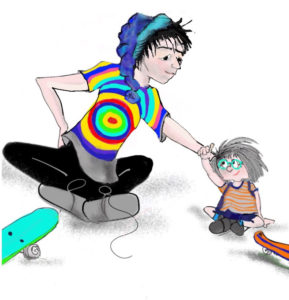The Wellbeing Stories are aimed at the 9-13 age group and each deals with a relevant issue in their lives. Based on resilience research and combining positive and narrative psychology, the wellbeing stories offer teachers and parents an opportunity to raise issues with young people in a safe and fun way. They show that some ways of thinking are helpful and others get in the way of wellbeing.
William and the Worry Wart is all about how a worry can get out of hand and become a panic monster. This story is about test anxiety, how it can get out of control and what might help. It is told by Pete, William’s older brother, who enlists the help of Common Sense and ZIP so Willliam gets through the tests without falling apart.
Children worry about all sorts of things. They may become socially anxious about how they are getting along with friends or be concerned about what is going on at home, especially where there is conflict or someone is sick. It is very common for young people to be anxious about tests and worry about how well they will do. We know that childhood anxiety is growing in the Western world as individuals compare themselves to others and fear not coming up to scratch. One of the most common bullying phrases is ‘you’re a loser’ – and no-one wants to be seen as one.
Educators, schools and students may judge themselves and others by scores rather than by all their many strengths and qualities. When this becomes the norm, people can get the impression that the only things that matter are those that can be measured. What – and who – comes at the top is valued and the rest are not.
If worries drag us down all the time – or even worse grow to the point of becoming panic – then this can seriously undermine our wellbeing and the  ability to function well. Very few people get away with not having a Worry Wart at all – and if it stays nice and small it can actually be helpful. It is the voice that reminds us to be prepared, to check we have what we need and stops us taking silly risks, and in fact can be helpful at times in keeping us aware of
ability to function well. Very few people get away with not having a Worry Wart at all – and if it stays nice and small it can actually be helpful. It is the voice that reminds us to be prepared, to check we have what we need and stops us taking silly risks, and in fact can be helpful at times in keeping us aware of  possible dangers and stimulating action. But when it becomes a panic monster the ability to think straight is lost and the result can be a melt-down.
possible dangers and stimulating action. But when it becomes a panic monster the ability to think straight is lost and the result can be a melt-down.
Panic can happen when someone feels under threat. The amygdala is a small organ in the limbic system – the part of the brain that deals with emotions. It is the seat of emotional memory and is there to respond to perceived threat. It sends rapid messages to the body to prepare to fight, freeze or flee. Some people have a sensitive amygdala that reacts strongly when a bad memory is triggered. Teachers may find it hard to understand why a pupil is so upset but there will always be a reason somewhere. Children need some time to calm down before they can engage in any fruitful conversation.
 In this story, the Worry Wart is encouraged to become a Panic Monster by SoBS – the Sprite of Bad Stories. She represents the voice in your head which hooks into anything that is negative. She sees the worst in everything and the worst in everyone. People are often attracted to bad news so she often has a good time spreading it around!
In this story, the Worry Wart is encouraged to become a Panic Monster by SoBS – the Sprite of Bad Stories. She represents the voice in your head which hooks into anything that is negative. She sees the worst in everything and the worst in everyone. People are often attracted to bad news so she often has a good time spreading it around!
The positive voices in this story are Common Sense, who helps William have a different view of things based in what is real rather than imagination, and ZIP who is the opposite of SoBS and sees the best and the possible.



